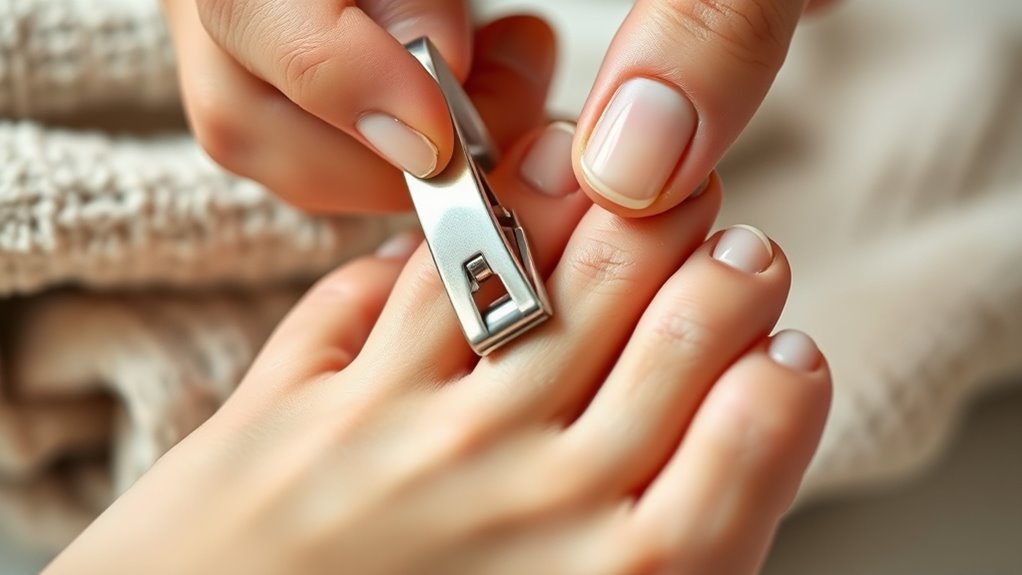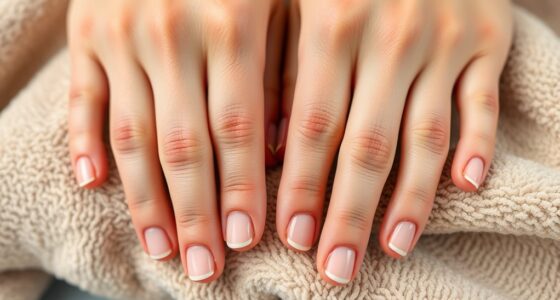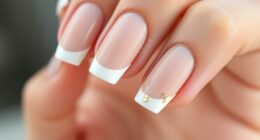To trim your toenails safely, use sharp, sterilized tools designed for toenails, and cut straight across to prevent ingrown nails. Trim after a warm bath when your nails are soft, and guarantee good lighting to see clearly. Avoid cutting too short or digging into the corners, and gently file any sharp edges afterward. Keeping proper hygiene and skincare habits will support healthy nails—continue exploring for more expert tips on maintaining toenail health.
Key Takeaways
- Always trim toenails straight across to prevent ingrown nails and reduce pressure on the sides.
- Use sharp, sterilized tools designed for toenails to ensure clean cuts and prevent infections.
- Trim nails after a bath or shower when they are soft for easier and safer cutting.
- Avoid cutting nails too close to the skin or rounding edges to prevent injuries and fungal entry.
- Maintain proper hygiene, dry feet thoroughly, and moisturize to support healthy toenail growth.
Gather the Right Tools for Toenail Care

To trim your toenails safely, you need to start with the right tools. Use sharp, high-quality toenail scissors or clippers designed for toenails—they give a clean cut and reduce the risk of injury. Sterilize your tools regularly to prevent toenail fungus and infection. Never use dull or makeshift tools, as they can cause jagged edges that may lead to ingrown toenails. Picking the right tools helps you trim evenly and avoid cutting too deep, which is vital for ingrown prevention. If you have health conditions or sensitive skin, consider tools with cushioned or ergonomic handles for better control. Proper tools are essential for maintaining healthy toenails and avoiding complications like fungal growth or ingrown toenails. Additionally, choosing tools that are appropriate for exfoliating dead skin cells can improve overall toenail health and prevent buildup that contributes to fungal issues.
Choose the Optimal Time and Environment for Trimming
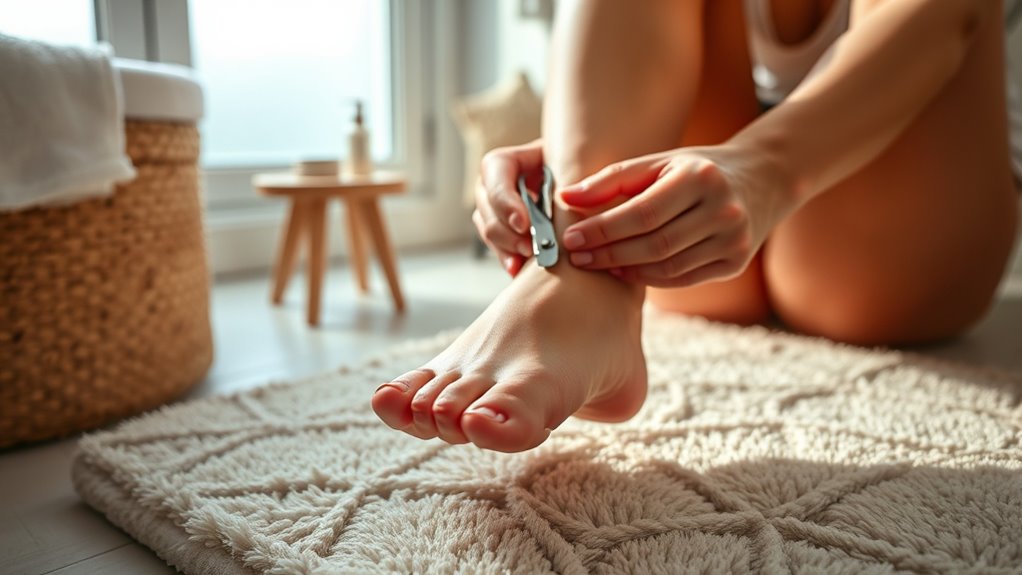
Choosing the right time and environment for trimming your toenails can make the process safer and more comfortable. Aim to trim toenails after a bath or shower when they’re soft, which improves toenail hygiene and reduces the risk of injury. Pick a well-lit, quiet space free of distractions to guarantee steady hands and precise cuts. Consistency is key; following a regular nail trimming schedule helps prevent ingrown nails and infections. Consider your daily routine and choose a time when you’re relaxed and alert. Additionally, understanding proper hygiene practices can further reduce the risk of bacterial or fungal infections. Maintaining optimal lighting conditions can also help you see clearly and avoid accidental cuts. Incorporating sound healing principles such as maintaining a calm environment may also help you stay relaxed during the process. Using appropriate tools, like sharp nail clippers, ensures cleaner cuts and minimizes injury risks.
Proper Technique for Cutting Toenails

When trimming your toenails, using the correct technique helps prevent injury and promotes healthy nails. Always cut straight across to avoid ingrown toenails, which can become painful or infected. Use clean, sharp nail scissors or clippers, and avoid digging into the corners. Never trim too close to the skin, as this can trigger toenail fungi or cause infections. If your nails are thick or difficult to cut, soften them with warm water first. Be gentle and controlled, applying steady pressure. Avoid tearing or ripping the nails, which can lead to jagged edges and potential fungal entry points. Proper technique ensures your toenails stay healthy, reduces discomfort, and minimizes the risk of complications like ingrown nails or fungal growth. Additionally, maintaining an organized and personalized workspace can help you follow regular nail care routines more effectively. Regularly inspecting your nails and using the right tools can also prevent nail infections and promote overall nail health. Incorporating AI detection methods in your routine can also assist in identifying early signs of fungal issues or other abnormalities, leading to prompt treatment and better nail health. Staying informed about innovations in nail care technology can further enhance your routine and prevent common problems.
How to Prevent Common Toenail Issues During Trimming

Preventing common toenail issues during trimming starts with paying close attention to the health of your nails and implementing simple precautions. Always use clean, sharp tools to avoid introducing bacteria that can lead to nail fungus. Don’t cut your nails too short or rounded at the edges, as this increases the risk of ingrown toenails. Trim straight across to maintain proper nail shape and reduce pressure on the sides. Avoid sharing nail tools to prevent infection. Keep your feet dry and clean, since moisture fosters fungal growth. If you notice redness, swelling, or pain, stop trimming immediately and consult a healthcare professional. Taking these precautions helps minimize the chances of developing nail fungus or ingrown toenails during trimming. Additionally, understanding proper sanitation practices can further reduce the risk of infections. Maintaining nail health through proper trimming techniques contributes to overall foot health and prevents complications. Being aware of common toenail problems can help you identify issues early and seek appropriate care.
Tips for Maintaining Healthy Toenails After Cutting
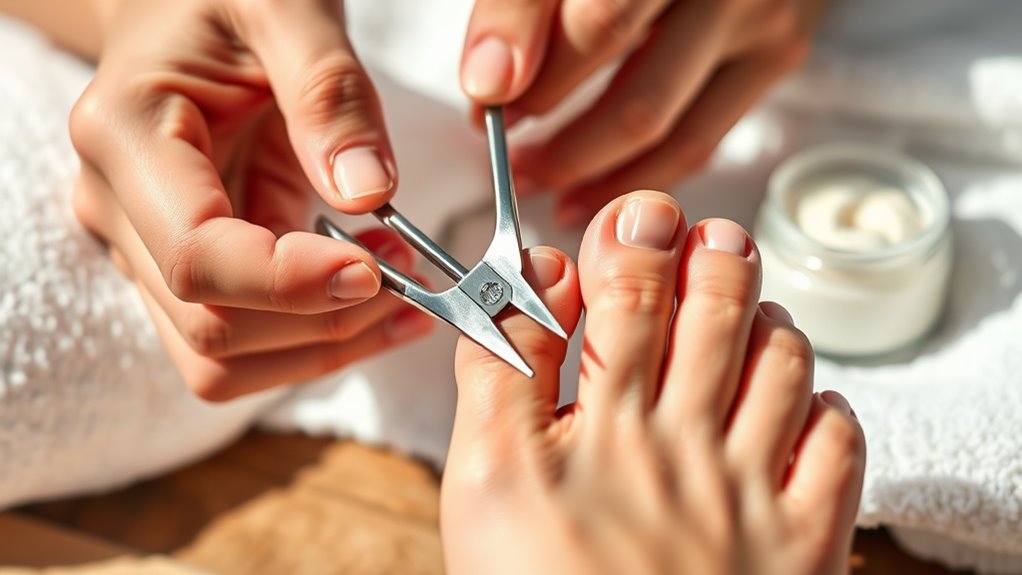
To keep your toenails healthy after trimming, maintaining a consistent foot care routine is essential. Regularly clean and dry your feet thoroughly to prevent toenail fungi, which thrive in damp environments. Moisturize your nails and surrounding skin to avoid dryness and cracking. Additionally, focus on toenail shape correction, gently filing any sharp edges to prevent snagging or injury. Be mindful of your footwear, opting for breathable shoes that promote airflow. Proper hygiene and careful maintenance help reduce fungal risks and keep your toenails strong. Remember to avoid aggressive cutting, which can cause trauma and irregular toenail shape. Using appropriate tools designed for toenail care can also help prevent injury and ensure safe trimming. Consistency is key—by following these tips, you’ll support healthy toenails and prevent issues down the line.
Frequently Asked Questions
How Often Should I Trim My Toenails for Optimal Health?
You should trim your toenails every 4 to 6 weeks to maintain proper nail care and hygiene practices. Regular trimming helps prevent issues like ingrown nails and fungal infections. If your nails grow quickly or you notice any discomfort, consider trimming more frequently. Always use clean, sharp tools and avoid cutting too short. Keeping a consistent schedule guarantees your toenails stay healthy and reduces the risk of common foot problems.
Can Trimming Toenails Help Prevent Fungal Infections?
Ever wonder if trimming your toenails can stop fungal infections? It definitely plays a role in fungal prevention by maintaining good nail hygiene. When you trim properly, you remove dead tissue and prevent moisture buildup—both perfect conditions for fungi to thrive. Regular trimming keeps your nails clean and healthy, making it harder for infections to take hold. So, yes, good nail hygiene through careful trimming is a simple yet effective way to protect your feet.
What Are Signs of Toenail Problems Requiring Medical Attention?
If you notice toenail discoloration or an unusual toenail shape, it’s time to see a doctor. These signs can indicate infections, fungal issues, or other health problems. Also, watch for pain, swelling, or if your toenails become brittle or separate from the nail bed. Prompt medical attention helps prevent complications and guarantees proper treatment, keeping your feet healthy and pain-free.
Is It Safe to Trim Toenails if I Have Diabetes?
Imagine you’re walking a tightrope—balancing safety and health. If you have diabetes, it’s crucial to prioritize diabetic foot care and nail trimming techniques carefully. While gentle trimming can be safe, you should avoid cutting too deep or using sharp tools. Regularly consult a healthcare provider for guidance and consider professional pedicures. Your feet deserve cautious care to prevent complications like infections or ulcers.
Are There Specific Toenail Trimming Techniques for Ingrown Toenails?
When managing ingrown toenails, you should use proper trimming tools, like sterilized nail scissors or clippers, to avoid further irritation. Trim the nail straight across to prevent it from digging into the skin, avoiding rounded edges. Be gentle, and don’t cut too short. For persistent issues, seek professional ingrown toenail management. This technique helps reduce pain and promotes healing while preventing future ingrown toenails.
Conclusion
By following these safe trimming tips, you can keep your toenails healthy and avoid painful issues. Even if you’re worried about accidentally cutting too close, remember that taking your time and using the right tools makes all the difference. Consistent, gentle care guarantees your toenails stay strong and problem-free. So don’t skip your routine—your feet will thank you for the effort! With a little care, healthy toenails are well within your reach.
